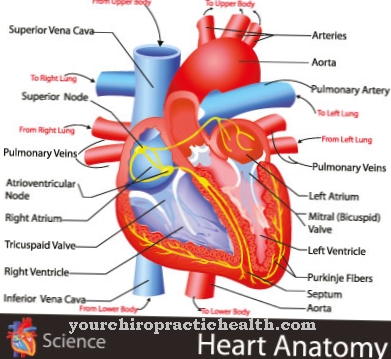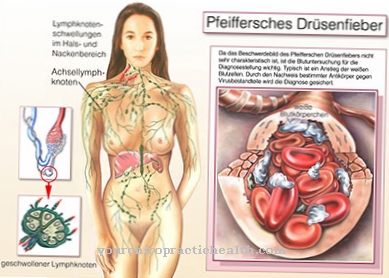Hyperglycemia or Hypoglycemia is an on-going symptom of diabetes and denotes high blood sugar levels. Hyperglycaemia can be avoided with proper nutrition, medication and monitoring of values.
What is hyperglycemia?

© joshya - stock.adobe.com
Hyperglycemia or high blood sugar occurs in people with diabetes. Many causes can lead to hyperglycemia in people with diabetes; These include the choice of food intake or physical activity, illness, medication, or inadequate administration of medication to reduce blood sugar levels.
It is very important to treat hyperglycemia because if left untreated hyperglycemia can have very serious consequences and lead to serious side effects; a diabetic coma can lead to direct admission to the emergency room. In the long term, persistent hyperglycemia, although not particularly severe, can affect the eyes, kidneys, nerves, or heart.
causes
The causes for Hyperglycemia are directly related to the production of the hormone insulin or its maintenance in the blood. During digestion, the body breaks down carbohydrates, such as those from bread, sugar, rice, and pasta, into various sugar molecules.
One of these molecules is glucose, one of the most important sources of energy for the body. Glucose is scattered into the blood immediately after eating. But without the help of insulin, which is produced by the pancreas, the body's cells cannot absorb blood sugar.When more glucose is absorbed, the body makes more insulin to get the sugar into cells.
The blood sugar is directed into the cells until the level in the blood returns to normal. Diabetes changes the effects of insulin on the body. Either the body is not making enough insulin to process blood sugar or the body is no longer responding normally to the hormone, which also causes hyperglycemia.
Symptoms, ailments & signs
Hyperglycemia can cause a wide variety of symptoms. When the blood sugar level is high, it initially leads to tiredness and exhaustion. Patients often feel exhausted and have difficulty getting out of bed in the morning. In addition, it is difficult to fall asleep and stay asleep. Usually there is also an increased appetite and excessive thirst.
As a result, those affected often have to urinate, and often only small amounts of urine are excreted. Hyperglycemia can also affect the skin, causing dry and flaky skin. Wound healing is usually disturbed and injuries keep opening up.
In addition, there is the typical itching of the skin, which occurs mainly on the arms and back. A high blood sugar level can also cause headaches, nausea and vomiting. There is an increased susceptibility to colds and other infections.
Externally, hyperglycaemia can manifest itself as reddened skin and a flaky scalp. Due to the ketones in the urine, the breath takes on an acetone odor, which is reminiscent of nail polish remover. The eyes are often reddened or black borders form around the eyes. If the course is severe, the patient loses consciousness and falls into a coma.
Diagnosis & course
People with diabetes suffer intermittently Hyperglycemia. After an appropriate diagnosis of diabetes, the doctor will determine the best blood sugar levels for the patient.
The patient tries to maintain these levels through medication and nutrition. The closer he moves to this level, the better he will feel. In order to regulate the blood sugar level, people with diabetes will also be able to check their levels at home on a daily basis. There are special devices for this. This can be used to directly counteract signs of hyperglycaemia. Another test is usually carried out three to four times at the doctor's office.
It determines how consistent the blood sugar values have been in the previous months and can be an important benchmark for whether the patient has the hyperglycaemia "under control".
Complications
The increased blood sugar level can lead to various complaints and complications. In most cases, the person will need to drink increased amounts of fluids to make up for the excess sugar and will suffer from frequent urination. This complaint can also have a negative effect on the psyche and lead to depression or other psychological upsets.
The patient's skin and mouth become dry, and most of them experience vomiting and nausea. It is not uncommon for dizziness and loss of consciousness to occur. Falling in a fainting attack can injure the person concerned. Furthermore, mental confusion can also occur, which is accompanied by impaired vision.
In the worst case, the person affected falls into a so-called diabetic coma. Hyperglycaemia can be treated relatively well. In most cases, no medical treatment is necessary, so that the person affected can counteract the symptoms through a healthy lifestyle. Without treatment, hyperglycemia can lead to organ damage and ultimately death. There are no further complications and life expectancy is usually not reduced by the hyperglycaemia.
When should you go to the doctor?
Symptoms such as frequent urination, increased thirst and dry skin suggest diabetes. If the symptoms persist for a long time, a doctor must be consulted. If there are other signs of hyperglycaemia, such as faintness, visual disturbances or confusion, medical advice is required. Diabetics who eat one-sidedly and have a generally unhealthy lifestyle are particularly prone to hypoglycaemia.
Affected people should see their family doctor immediately with the symptoms mentioned and also consult a nutritionist. If the symptoms are pronounced, the prescribed medication usually also has to be adjusted. The medication is often poorly adjusted or the individual diet has to be adjusted. If the sick person feels signs of a heart attack or falls into a diabetic coma, the emergency doctor must be called. Until medical help arrives, first aid measures must be provided. Then the person concerned needs a comprehensive examination in the hospital. The cause of the collapse needs to be determined and corrected to avoid further complications.
Doctors & therapists in your area
Treatment & Therapy
The authoritative treatments of the Hyperglycemia is in control of the patient and must be performed daily. To a large extent it consists of a healthy and balanced lifestyle. Physical activity and sport usually have a very positive effect on blood sugar levels, and the prescribed medication should always be taken as prescribed by the doctor.
A diet plan must also be followed to avoid hyperglycemia. This mainly consists of a significant reduction in sugary foods. Whenever there is any uncertainty about blood sugar levels or small signs of hyperglycemia, the patient must measure his values in order to counteract them in time. The independent injection of insulin into the bloodstream may also be necessary if the body's own production is no longer sufficient.
Serious effects of hyperglycemia can lead to the emergency room. Dehydration is often combated there, as well as insufficient supply of the cells with electrolytes and the direct administration of insulin into the bloodstream.
Outlook & forecast
The prognosis of hyperglycaemia is determined according to the individual health criteria of a patient as well as their cooperation to improve their health. The underlying cause of the hypoglycemia is diabetes. According to the current medical treatment options, this has a chronic disease course.
Despite all efforts, there is currently no cure. Nevertheless, by restructuring their way of life and their nutritional plan, the patient can achieve significant relief from the symptoms and regulate the excess sugar independently. Normally, a diagnosed diabetes is followed by long-term therapy with a form of drug treatment. If the drugs are discontinued during the therapy that is taking place, an immediate relapse of the symptoms is to be expected. New symptoms develop and there is also a risk of comatose health. In addition, the life expectancy of those affected is shortened without treatment.
A good prognosis is achieved if the treatment plan developed and a change in living conditions are observed. This is especially true if there are no other illnesses and there are no complications. If there are sequelae or sequelae, the overall prognosis worsens, as some diseases are considered incurable. In particular, impaired vision or organ damage worsen the general health of the patient and have a negative impact on general life expectancy.
prevention
In order to avoid hyperglycemia, the patient should stick to his or her diet plan. When and how much they eat is especially important for people with diabetes to control their blood sugar levels. Depending on the treatment, the blood sugar level must be measured independently on a regular basis. A change in the dosage of medication is usually necessary when the scope of physical activity changes.
Aftercare
Follow-up care for hypoglycaemia consists primarily of taking preventive action and preventing further hyperglycaemia. The medication required for this should be taken regularly and as directed by a doctor. The medication should always be at hand everywhere.
It is also advisable to inform friends, acquaintances, colleagues and, if necessary, other people about the risk of hyperglycaemia so that in an emergency there is clarity and can be treated more quickly. A sensitization of the people close to the symptoms of the hypoglycaemia should take place.
An individual emergency plan can also be drawn up. In addition, it is important to pay close attention to the right diet and sufficient exercise. Particular attention should be paid to an adequate intake of fluids every day. In everyday life, stressful situations should be minimized if possible, or in the best case completely prevented. The excitement releases the hormone adrenaline, which also increases the blood sugar level.
A good general state of health should always be aimed for and infections should be recognized and treated quickly. Infections lead to increases in blood sugar levels. In addition, regular and conscientious blood sugar monitoring should take place. The measuring device used for this should also be checked regularly for its functionality in order to avoid incorrect measurement results.
You can do that yourself
In hyperglycaemia, a lack of insulin leads to an increased concentration of sugar in the person's blood. In order to counteract this increased blood sugar, the person concerned must adhere to a strict diet, which has been discussed in advance with a doctor and / or nutritionist. Food and beverages that are high in sugar should be avoided. According to the glycemic index, foods such as white flour or fruit juices have a blood sugar-increasing effect. On the other hand, the consumption of pulses and nuts are recommended, as they only slightly increase blood sugar levels. Adequate exercise through exercise can also supplement this diet.
Hyperglycaemia is often a symptom of diabetes. In this case, the person concerned has to measure and document his blood sugar level at a given and always the same time during the day. In addition, the person concerned has to inject himself regularly with insulin using an insulin pen. An alternative is an insulin pump, which the patient always carries with him and which regularly injects insulin into the affected person independently.
The hyperglycemia can also be triggered by other factors. One cause of hyperglycemia is stress. In this case, the person concerned should take it easy, treat himself to regular breaks and ensure that he or she gets enough sleep.


.jpg)


.jpg)
.jpg)


















.jpg)


